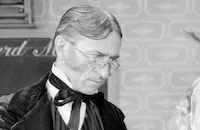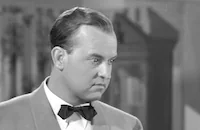Last of the Wild Horses
Cast & Crew
Robert L. Lippert
James Ellison
Mary Beth Hughes
Jane Frazee
Douglas Dumbrille
James Millican
Film Details
Technical Specs

Synopsis
In Oregon, Duke Barnum is about to make his debut as a stagecoach robber when he decides to come to the aid of a lone rider being pursued by three men and wounds one during the chase. In nearby Jacksonville, the stagecoach driver tells Sheriff Harrison that he spotted the would-be hold-up man from half a mile away through field glasses. Duke, meanwhile, meets Jane Cooper, daughter of Charlie Cooper the owner of the Double C ranch. Confined to a wheelchair because of an injury suffered during a stampede, Cooper has turned over management of the ranch to a cowboy named Riley. Several neighboring ranchers are now complaining to Cooper that the Double C is removing too many mares from the local herds of wild horses, thus diminishing the herd's ability to perpetuate itself. The sheriff comes to visit the Double C ranch looking for the hold-up man, and while he is there, the three horsemen Duke confronted earlier show up. The sheriff arrests Duke for assault and suspicion of robbery, but Duke is cleared with the help of Terry Williams, the lone rider, who is the pretty ward of "Remedy" Williams a local rancher. Jane lectures her father and he agrees to a year's moritorium on taking horses. However, acting on his own initiative, Riley decides to round up as many horses as possible. Later, having tipped off a small rancher as part of a set-up, Riley decides to move some horses through the territory at night. Several ranchers witness the horse run, during which Riley's men deliberately drop a Double C branding iron in order to accelerate the hostilities between the ranchers and Cooper. As Cooper was responsible for the sheriff being hired, Riley has no difficulty in arranging for some Double C men to be deputized. Riley's men put Double C horses in another rancher's corral, accuse him of rustling and kill him, saying later that he resisted arrest. When the small ranchers join forces against Cooper, Duke tries to defuse the situation by talking with Cooper, and as he leaves the ranch, he accidentally drops his bandana. Cooper then overhears Riley arranging with one of his henchmen, Hank, to plant more horses at another ranch. Cooper draws his gun on Riley, who overpowers him, strangling him with Duke's bandana. Duke is charged with Cooper's murder while Riley pays off Hank, who then leaves. No lawyer will defend Duke so Remedy attempts to do so, but Duke is found guilty. However, with Remedy's help, Duke escapes and heads for a hideout in a cave, but, en route, is shot in the shoulder by Jane. Now free of any opposition, Riley takes over several ranches through foreclosure. Later while collecting his mail, Remedy accidentally opens a letter for Riley, in which Hank demands more money in exchange for his silence regarding Copper's murder. Remedy encounters Riley, who discovers he has the letter, chases after him and shoots him while he is crossing a river. At Remedy's ranch, where Duke is now in hiding, Jane sees Terry visiting Duke and offers to help him escape. The wounded Remedy gives the letter to Duke who goes off to see the sheriff. Duke then fights it out with Riley and defeats him.

Director
Robert L. Lippert
Cast

James Ellison
Mary Beth Hughes

Jane Frazee

Douglas Dumbrille

James Millican
Reed Hadley

Olin Howlin
William Haade

Grady Sutton
Stanley Andrews
Rory Mallinson
Crew
Victor Appel
Alfred Berke
Noble Craig
Walter M. Dalgleish
Perry Finnerman
Albert Glasser
Milton Gold
Charles S. Gould
Jack Harvey
Moree Herring
Carl K. Hittleman
Benjamin H. Kline
Harry Kosnick
Paul Landres
Paul Landres
Robert L. Lippert
Robert L. Lippert
Robert L. Lippert
Ray Mercer
Yolanda Molinari
Stanley Price
David Ragin
David Sadler
Willard H. Sheldon

Film Details
Technical Specs

Quotes
Trivia
Notes
The film was shot on location in Jacksonville, Oregon. Before the opening credits, a shot of a Jacksonville street in 1948 is seen and dissolves into a shot of the same street dressed for the time period of the film. This was producer Robert L. Lippert's first film as director.












